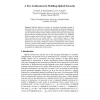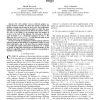139 search results - page 14 / 28 » The Domatic Number of Regular Graphs |
DAM
2008
13 years 7 months ago
2008
A mobile agent (robot), modeled as a finite automaton, has to visit all nodes of a regular graph. How does the memory size of the agent (the number of states of the automaton) inf...
JEI
2006
13 years 7 months ago
2006
To prevent large error accumulation in multiple image registration considering real-time applications, we propose a new fast global mosaic method using sequential block matching in...
IPPS
1999
IEEE
13 years 12 months ago
1999
IEEE
Multihop lightwave networks are becoming increasingly popular in optical networks. It is attractive to consider regular graphs as the logical topology for a multihop network, due t...
IMCSIT
2010
13 years 5 months ago
2010
We will consider balanced directed graphs, i.e., graphs of binary relations, for which the number of inputs and number of outputs are the same for each vertex. The commutative diag...
DM
2008
13 years 7 months ago
2008
A (d, d + 1)-graph is a graph whose vertices all have degrees in the set {d, d + 1}. Such a graph is semiregular. An (r, r + 1)-factorization of a graph G is a decomposition of G ...


